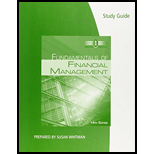
Study Guide For Brigham/houston's Fundamentals Of Financial Management, 14th
14th Edition
ISBN: 9781305403895
Author: Eugene F. Brigham, Joel F. Houston
Publisher: Cengage Learning
expand_more
expand_more
format_list_bulleted
Question
Chapter 5, Problem 32P
Summary Introduction
To calculate: Value of deposit to reach the financial goal of $10,000 in six years at 8% annual effective rate with 6th year deposit to be less than $1500.
Expert Solution & Answer
Want to see the full answer?
Check out a sample textbook solution
Students have asked these similar questions
finance qn
None
None
Chapter 5 Solutions
Study Guide For Brigham/houston's Fundamentals Of Financial Management, 14th
Ch. 5 - Prob. 1QCh. 5 - Explain whether the following statement is true or...Ch. 5 - If a firms earnings per share grew from 1 to 2...Ch. 5 - Prob. 4QCh. 5 - Prob. 5QCh. 5 - The present value of a perpetuity is equal to the...Ch. 5 - Banks and other lenders are required to disclose a...Ch. 5 - What is a loan amortization schedule, and what are...Ch. 5 - Prob. 1PCh. 5 - Prob. 2P
Ch. 5 - FINDING THE REQUIRED INTEREST RATE Your parents...Ch. 5 - TIME FOR A LUMP SUM TO DOUBLE If you deposit money...Ch. 5 - TIME TO REACH A FINANCIAL GOAL You have 42,180.53...Ch. 5 - Prob. 6PCh. 5 - Prob. 7PCh. 5 - LOAN AMORTIZATION AND EAR You want to buy a car....Ch. 5 - PRESENT AND FUTURE VALUES FOR DIFFERENT PERIOOS...Ch. 5 - Prob. 10PCh. 5 - GROWTH RATES Shalit Corporations 2014 sales were...Ch. 5 - EFFECTIVE RATE OF INTEREST Find the interest rates...Ch. 5 - Prob. 13PCh. 5 - FUTURE VALUE OF AN ANNUITY Find the future values...Ch. 5 - Prob. 15PCh. 5 - Prob. 16PCh. 5 - EFFECTIVE INTEREST RATE You borrow 85,000; the...Ch. 5 - Prob. 18PCh. 5 - FUTURE VALUE OF AN ANNUITY Your client is 40 years...Ch. 5 - Prob. 20PCh. 5 - Prob. 21PCh. 5 - Prob. 22PCh. 5 - FUTURE VALUE FOR VARIOUS COMPOUNDING PERIODS Find...Ch. 5 - Prob. 24PCh. 5 - FUTURE VALUE OF AN ANNUITY Kind the future values...Ch. 5 - PV AND LOAN ELIGIBILITY You have saved 4,000 for a...Ch. 5 - EFFECTIVE VERSUS NOMINAL INTEREST RATES Bank A...Ch. 5 - Prob. 28PCh. 5 - Prob. 29PCh. 5 - Prob. 30PCh. 5 - REQUIRED LUMP SUM PAYMENT Starting next year, you...Ch. 5 - Prob. 32PCh. 5 - FV OF UNEVEN CASH FLOW You want to buy a house...Ch. 5 - AMORTIZATION SCHEDULE a. Set up an amortization...Ch. 5 - Prob. 35PCh. 5 - NONANNUAL COMPOUNDING a. You plan to make five...Ch. 5 - Prob. 37PCh. 5 - Prob. 38PCh. 5 - REQUIRED ANNUITY PAYMENTS Your father is 50 years...Ch. 5 - Prob. 40PCh. 5 - Prob. 41SPCh. 5 - Prob. 42IC
Knowledge Booster
Learn more about
Need a deep-dive on the concept behind this application? Look no further. Learn more about this topic, finance and related others by exploring similar questions and additional content below.Similar questions
- Muskoka Tourism has announced a rights offer to raise $30 million for a new magazine, titled ‘Discover Muskoka’. The magazine will review potential articles after the author pays a nonrefundable reviewing fee of $5,000 per page. The stock currently sells for $52 per share and there are 3.9 million shares outstanding. Required What is the maximum possible subscription price? What is the minimum? If the subscription price is set at $46 per share, how many shares must be sold? How many rights will it take to buy one share? What is the ex-rights price? What is the value of a right?arrow_forwardNorthern Escapes Inc. has 225,000 shares of stock outstanding. Each share is worth $73, so the company’s market value of equity is $16,425,000. Suppose the firm issues 30,000 new shares at the following prices: $73, $69, and $60. What will the effect be of each of these alternative offering prices on the existing price per share?arrow_forwardNeed answer correctly.arrow_forward
- Muskoka Tourism has announced a rights offer to raise $30 million for a new magazine, titled ‘Discover Muskoka’. The magazine will review potential articles after the author pays a nonrefundable reviewing fee of $5,000 per page. The stock currently sells for $52 per share and there are 3.9 million shares outstanding.arrow_forwardSs stores probarrow_forwardHenrietta’s Pine Bakery Corporation would like to raise $75 million to finance its expansion into new markets. The company will sell new shares of equity via a general cash offering to raise the needed funds. If the offer price is $15 per share and the company’s underwriters charge a 6% spread, how many shares need to be sold?arrow_forward
arrow_back_ios
SEE MORE QUESTIONS
arrow_forward_ios
Recommended textbooks for you
 EBK CONTEMPORARY FINANCIAL MANAGEMENTFinanceISBN:9781337514835Author:MOYERPublisher:CENGAGE LEARNING - CONSIGNMENTPrinciples of Accounting Volume 2AccountingISBN:9781947172609Author:OpenStaxPublisher:OpenStax College
EBK CONTEMPORARY FINANCIAL MANAGEMENTFinanceISBN:9781337514835Author:MOYERPublisher:CENGAGE LEARNING - CONSIGNMENTPrinciples of Accounting Volume 2AccountingISBN:9781947172609Author:OpenStaxPublisher:OpenStax College

EBK CONTEMPORARY FINANCIAL MANAGEMENT
Finance
ISBN:9781337514835
Author:MOYER
Publisher:CENGAGE LEARNING - CONSIGNMENT

Principles of Accounting Volume 2
Accounting
ISBN:9781947172609
Author:OpenStax
Publisher:OpenStax College



How To Calculate The Present Value of an Annuity; Author: The Organic Chemistry Tutor;https://www.youtube.com/watch?v=RU-osjAs6hE;License: Standard Youtube License